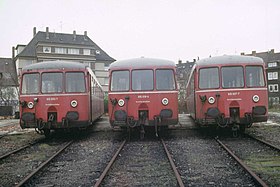DB Class ETA 150
| DB Class ETA/ESA 150 DB Class 515/815 |
|
|---|---|

Three 515/815 railbuses at Betriebswerk Hildesheim
|
|
| Number(s) | ETA 515 001–033 ETA 515 101–138 ETA 515 501–661 ESA 150 001–216 |
| Quantity | 232 power cars 216 driving cars |
| Manufacturer | SSW, Rathgeber, O&K WMD, Wegmann & Co. |
| Year(s) of manufacture | 1955 |
| Retired | 1995 |
| Axle arrangement | Bo'2'(ETA) and 2'2'(ESA) |
| Type | BD4 or ABD4 and B4tr. |
| Length | 26.8 m (87 ft 11 1⁄8 in) (ETA) 26.8 m (87 ft 11 1⁄8 in) (ESA) |
| Empty weight | 49.0–56.0 t (48.2–55.1 long tons; 54.0–61.7 short tons) (ETA) |
| Top speed | 100 km/h (62 mph) |
| Power output (one hour) | 2× 150 kW (200 hp) = 300 kW (400 hp) |
| Range | 300 km (190 mi) |
| Capacity | 352–548 kWh (1,270–1,970 MJ) |
| Driving wheel diameter | 0.95 m (37.4 in) |
| Carrying wheel diameter | 0.95 m (37.4 in) |
| Brakes | Knorr |
| Seats | 59–86 (ETA) 81–100 (ESA) |
The accumulator cars of Class ETA 150 (Class 515 from 1968) were German railbuses used extensively by the Deutsche Bundesbahn (DB) over 40 years. The driving cars were very comfortable to travel in because they were quiet (despite the typical whine of its DC motors), rode well on the rails due to the weight of the batteries and were pollution-free (no smoke or fumes). They ran on both main and branch lines.
They were very popular with passengers. The vehicles were nicknamed Akkublitz (Battery Lightning), Säurebomber (Battery Acid Bombers), Steckdosen-InterCity (Socket InterCitys), Taschenlampen-Express (Pocket Torch Express) or Biene Maja (Maya the Bee - due to its noise when under way).
As a result of many years of favourable experience with this type of vehicle (the Prussian state railways had placed accumulator railcars in service as early as 1907 – these were later the Class ETA 178 in the Deutsche Reichsbahn) and of the evaluation of the results with the Class ETA 176 prototypes, the DB placed 232 Class ETA 150 power cars and 216 of their associated Class ESA 150 driving cars in service between 1953 and 1965.
The DB preferred to employ these two-coach sets on relatively level routes. They were rarely used on hilly lines due to the resultant high current consumption and hence limited range. In the main this only affected those vehicles stationed at Wanne-Eickel, and which were used in the Wuppertal area.
The main areas of operation of the class, apart from the Ruhrgebiet, were Schleswig-Holstein, eastern Lower Saxony, eastern Rhineland-Palatinate (in the Westerwald forest), south Hesse, south Baden, and the region around Augsburg and Nördlingen. The last few railcars also worked in the area of the Rhine-Ruhr Transport Union (Verkehrsverbund Rhein-Ruhr) or VRR until 1995.
...
Wikipedia
